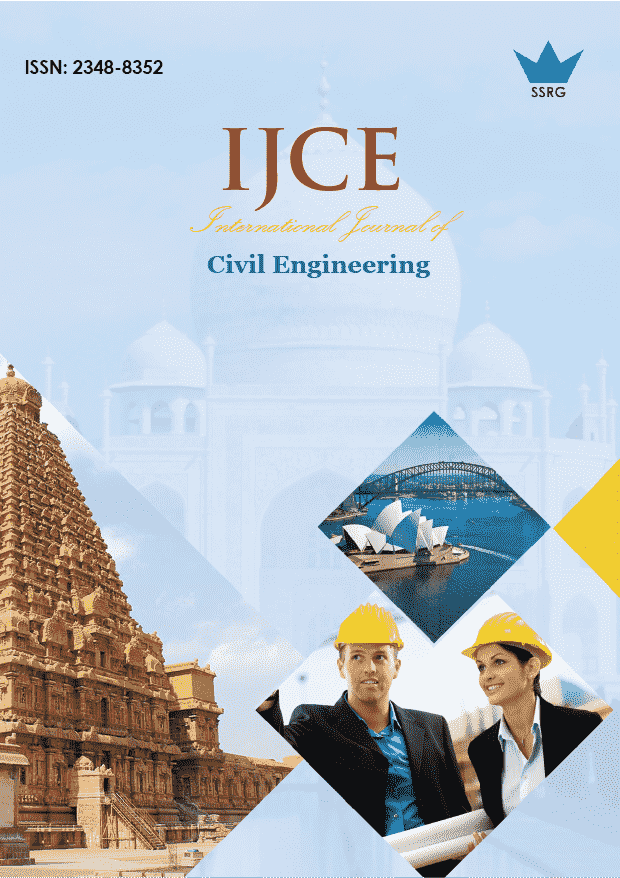Analysis of Foundations in Building Construction through the Implementation of Eurocode EC-7

| International Journal of Civil Engineering |
| © 2025 by SSRG - IJCE Journal |
| Volume 12 Issue 3 |
| Year of Publication : 2025 |
| Authors : Arsim Rapuca, Hysen Ahmeti |
How to Cite?
Arsim Rapuca, Hysen Ahmeti, "Analysis of Foundations in Building Construction through the Implementation of Eurocode EC-7," SSRG International Journal of Civil Engineering, vol. 12, no. 3, pp. 213-225, 2025. Crossref, https://doi.org/10.14445/23488352/IJCE-V12I3P121
Abstract:
During the construction of buildings, shallow foundations are often encountered for economic reasons; however, this approach is flawed and may lead to dangerous consequences for both the structure and the community at large. The bearing capacity of the foundation is one of the most critical aspects of geotechnical engineering. Loads from buildings are transmitted to the foundation through columns, load-bearing walls, or other structural components. The two fundamental criteria that must be satisfied in analyzing and designing a shallow foundation are stability and deformation requirements. The stability requirement ensures that the foundation does not experience shear failure under load, while the deformation requirement guarantees that the displacement of a structure remains within the permissible limits of the superstructure. When data on soil characteristics (such as cohesion, angle of internal friction, density, etc.) are available, the allowable bearing capacity can be calculated by considering shear failure. To design the foundations of a structure, it is essential to consider the foundation’s geometric shape, depth, loads, and physical and mechanical parameters according to the cited sources. In this work, four methods are employed to calculate the bearing capacity of the soil: the Terzaghi method, the Meyerhof method, the Hansen method, and the Vesic method, applying Eurocode EC7-1997:2004 to the foundation where the entire structure acts in order to achieve the permissible safety factors according to geotechnical design standards.
Keywords:
Method, Comparative, Physicomechanical, Parameters, Bearing capacity.
References:
[1] Braja M. Das, and Nagaratnam Sivakumar, Principles of Foundation Engineering: Si Edition, CL Engineering, 2018.
[Google Scholar] [Publisher Link]
[2] Ian Smith, Smith's Elements of Soil Mechanics, Wiley, pp. 1-704, 2021.
[Publisher Link]
[3] ISO 9001 Foundation Certification Training in Pristina Kosovo, Unichrone, 2022. [Online]. Available: https://unichrone.com/xk/iso-9001-foundation-training/pristina
[4] Hysen Ahmeti, and Edon Maliqi, “Geomechanical Research into Surface Coal Mining in Terms of Geotechnical Safety Substantiation,” Mining of Mineral Deposits, vol. 17, no. 3, pp. 22-31, 2023.
[CrossRef] [Google Scholar] [Publisher Link]
[5] Muni Budhu, Soil Mechanics and Foundations, Wiley, pp. 1-761, 2010.
[Google Scholar] [Publisher Link]
[6] Biswas Uprety, and Mihir Lal, “Standard Penetration Test in Geotechnical Engineering Site Investigations,” Journal of Emerging Technologies and Innovative Research, vol. 8, no. 4, pp. 119-127, 2021.
[Publisher Link]
[7] P.K. Robertson, and K. Cabal, Cone Penetration Testing Guide To, Gregg Drilling LLC: California, US, 2022.
[Google Scholar] [Publisher Link]
[8] George Geoffrey Meyerhof, “Some Recent Research on the Bearing Capacity of Foundations,” Canadian Geotechnical Journal, vol. 1, no. 1, 1963.
[CrossRef] [Google Scholar] [Publisher Link]
[9] Ming Xiao, Geotechical Engineering Design, Wiley, pp. 1-432, 2015.
[Google Scholar] [Publisher Link]
[10] Make Mannan, Bearing Capacity Theory is Code, Vesic, Hansen, Meyerhof, Skemptons, 2015. [Online]. Available: https://www.slideshare.net/KarnamBamel/bearing-capacity-theory-is-code-vesic-hansen-meyerhof-skemptons-usefulsearchorg
[11] Settle 3D: 3D Settlement for Foundation, Consolidation Analysis Verification Manual, 2022. [Online]. Available: https://static.rocscience.cloud/assets/verification-and-theory/Settle3/Settle3D_Consolidation_Verification_2022-01-11-205134_gxjq.pdf
[12] Karl Terzaghi, Theoretical Soil Mechanics, Wiley, pp. 1-510, 1943.
[Google Scholar] [Publisher Link]
[13] C. Venkatramaiah, Geotechnical Engineering, New Age International Publication (P) Limited, pp. 1-1063, 1995.
[Google Scholar] [Publisher Link]
[14] Saeed Shamloo, and Meysam Imani, “Upper Bound Solution for the Bearing Capacity of Rock Masses Considering the Embedment Depth,” Ocean Engineering, vol. 218, 2020.
[CrossRef] [Google Scholar] [Publisher Link]
[15] Xiao Gang Wang et al., “2D Slope Stability Analysis Based on Pan's Maximum Principle,” Bulletin of Engineering Geology and The Environment, vol. 79, pp. 4093-4105, 2020.
[CrossRef] [Google Scholar] [Publisher Link]
[16] R.S. Merifield, S.W. Sloan, and H.S. Yu, “Rigorous Plasticity Solutions for the Bearing Capacity of Two-Layered Clays,” Geotechnics, vol. 49, no. 4, pp. 471-490, 1999.
[CrossRef] [Google Scholar] [Publisher Link]
[17] Radoslaw L. Michalowski, and Lei Shi, “Bearing Capacity of Footings Over Two-Layer Foundation Soils,” Journal of Geotechnical Engineering, vol. 121, no. 5, 1995.
[CrossRef] [Google Scholar] [Publisher Link]
[18] Ashraf S. Osman, “Upper Bound Solutions for the Shape Factors of Smooth Rectangular Footings on Frictional Materials,” Computer and Geotechnics, vol. 115, 2019.
[CrossRef] [Google Scholar] [Publisher Link]
[19] Hazim Alkhafaji, Meysam Imani, and Ahmad Fahimifar, “Ultimate Bearing Capacity of Rock Mass Foundations Subjected to Seepage Forces Using Modified Hoek–Brown Criterion,” Rock Mechanics and Rock Engineering, vol. 53, pp. 251-268, 2020.
[CrossRef] [Google Scholar] [Publisher Link]
[20] “Eurocode 7: Geotechnical Design - Part 1: General Rules,” 2004.
[Publisher Link]
[21] Hysen Ahmeti, Ajet Ahmeti, and Ragip Behram, “The Impact of Coal Quality on Reduction of Environmental Pollution Researched Through Statistical Analysis,” Civil Engineering Journal, vol. 8, no. 8, pp. 1596-1605, 2022.
[CrossRef] [Google Scholar] [Publisher Link]
[22] Zenun Elezaj, and Alaudin Kodra, Geology of Kosovo, Pristina, 2008.
[Google Scholar]
[23] Hamid Mortazavi Bak et al., “Application of the Taguchi Method to Enhance Bearing Capacity in Geotechnical Engineering: Case Studies,” International Journal of Geomechnics, vol. 21, no. 9, 2021.
[CrossRef] [Google Scholar] [Publisher Link]
[24] Atila Demiröz, and Özcan Tan, “An Experimental Study for Settlement of Strip Foundation on Geogrid-Reinforced Sand,” Scientific Research and Essays, vol. 5, no. 21, pp. 3306-3312, 2010.
[Google Scholar] [Publisher Link]
[25] Gregory C. Ezeokpube et al., “Assessment of Mechanical Properties of Soil‐Lime‐Crude Oil‐Contaminated Soil Blend Using Regression Model for Sustainable Pavement Foundation Construction,” Advances in Materials Science and Engineering, vol. 2022, no. 1, pp. 1-18, 2022.
[CrossRef] [Google Scholar] [Publisher Link]

 10.14445/23488352/IJCE-V12I3P121
10.14445/23488352/IJCE-V12I3P121